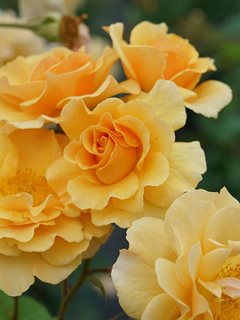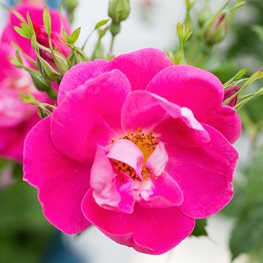How to Grow the Best Climbing Roses
The basics of growing and caring for an English garden staple—the climbing roseAn English-inspired garden wouldn’t be complete without a climbing rose; and with so many varieties available, it’s hard to pick just one. Many offer improved disease resistance and are easier to care for than their shrub-rose cousins. Climbing roses can provide a brilliantly colored, fragrant garden backdrop and repeat bloomers can set the scene all summer long, with some varieties blooming until late fall. When choosing the perfect variety for your garden, be sure to consider the mature size of the plant, as some can climb 12 to 14 feet tall and spread up to 10 feet wide.
On this page: Basics | Planting Climbing Roses | Climbing Rose Care | Pictures | Design Tips
THE BASICS
Zones:
Varieties available for zones 3 through 10.
Height/Spread:
6 to 14 feet tall, 3-6 feet wide, depending on the variety.
Exposure:
Full sun to light shade, certain types will tolerate shade better than others.
Bloom time:
Most will begin blooming late spring to early summer and continue to bloom until early fall — with cultivars such as Rosa ‘William Baffin’ blooming through fall until first frost. There are some old garden climbers that only bloom once a year, so check your variety's bloom time and schedule.
Flower color:
Pastel, bright, and multi-colored varieties available.
Types:
There are large- and small-flowered varieties, shorter and taller varieties, single- and repeat-blooming varieties, hybrid teas, old garden and modern types. Some varieties will climb only in warmer climates where they have a longer growing season, and will grow to be large shrubs in colder zones. There are also ramblers, with canes that are less rigid, allowing them to climb higher or to spread out along the ground. Check the specifics of the variety you are choosing to make sure it is well-suited for your zone and planting site.
PLANTING INSTRUCTIONS
When to plant:
Bareroot planting should be done in late winter or early spring, allowing the roots enough time to establish before hot summer weather.
Where to plant:
Climbing roses will grow and bloom best in a location with full sun, although they will tolerate light shade. A location with eastern exposure is best to protect the leaves from hot afternoon sun. Make sure the mature size and height of the plant is suitable for the location. Most varieties will require the support of a structure, whether it is an arbor, fence, trellis, or wall. However, if the goal is to get the climbing rose to cover a wall, it is recommended to use a trellis placed a few inches away from the wall to allow good air circulation.
How to plant:
Dig your planting hole wide and deep enough to accommodate the plant’s roots when spread out. Loosen the soil at the bottom of the hole to allow the roots to easily grow deeper. Center the plant in the hole with the branches pointing slightly toward the climbing structure. The grafting union should be just below the soil level. Fill in the hole and lightly pack the soil. Water well after planting.
Soil:
Climbing roses prefer slightly acidic, well-drained soils.
Other:
Climbing roses require a sturdy structure that they can be secured to, as they don’t have tendrils to attach themselves and they do not twine. Hand-tie the branches to the structure with stretchable fasteners so the growing canes are not damaged.
CLIMBING ROSE CARE
Training:
For the first year or two, climbers should be trained in the direction you want them to grow; pruning only to remove dead or diseased branches. This will allow the plant to establish itself and expand at the base for a fuller appearance.
Pruning:
After the first year or two, you can begin lightly pruning as needed in late winter to early spring for maintenance and shape; this will also help promote new growth. The main canes that come directly from the base should be pruned after flowering. The lateral canes produce the flowers and can be lightly pruned anytime of the year in order to keep the climber in shape. Deadheading (removing spent flowers) will encourage more flowering on repeat-blooming varieties. For more specifics, see: Pruning Climbing Roses.
Watering:
Climbing roses prefer consistent, regular watering; water deeply in the first year to establish roots. Mornings are best. Water at the base of the plant. Be careful not to overwater your roses, as they are more susceptible to fungal diseases if their feet are wet.
Amendments & Fertilizer:
Feed with a time-release fertilizer in early spring, before new growth begins. Water before and after feeding to prevent burning. A few inches of mulch around the base of the plant will help retain moisture through the warmer weather. Add some more mulch in the late fall, piling it up around the base of the plant to provide extra winter insulation. Remove the excess mulch when the ground begins to warm in the spring.
Diseases:
While most climbing roses offer better disease resistance than their shrubby cousins, they are still susceptible to black spot, anthracnose, powdery mildew, rust and other fungal problems caused by too much water, humidity and heat.
Pests:
They can also be the target of pests such as aphids, scale, whiteflies and rose cucurlio weevil. A strong jet of water gets rid of a lot of aphids and whitefly or you can try the sticky yellow cards that trap insects. Insecticidal soap acts quickly and on contact to get rid of rose pests.
Keep the ground around the base of the plant clear of dead leaves and flowers to help prevent disease and pest infestations. Choosing a location with full sun and good air circulation will also help.
Other:
Roses are listed as non-toxic to dogs, cats, and horses on the ASPCA Plant List. Rose buds have been referred to as “deer candy” and young green growth (when the thorns are still semi-soft) is also a favorite.
10 BEST CLIMBING ROSES
LANDSCAPE DESIGN TIPS
- Climbing roses are a nice complement to clematis.
- Perfect choice for formal & English-style gardens.
- Train on a fence, trellis or garden wall.
- Climb around a doorway or window.
- Allow to climb over an arbor or gateway to create a beautiful (and fragrant) entrance.
RELATED:
Flowering Vines
Types of Roses
















